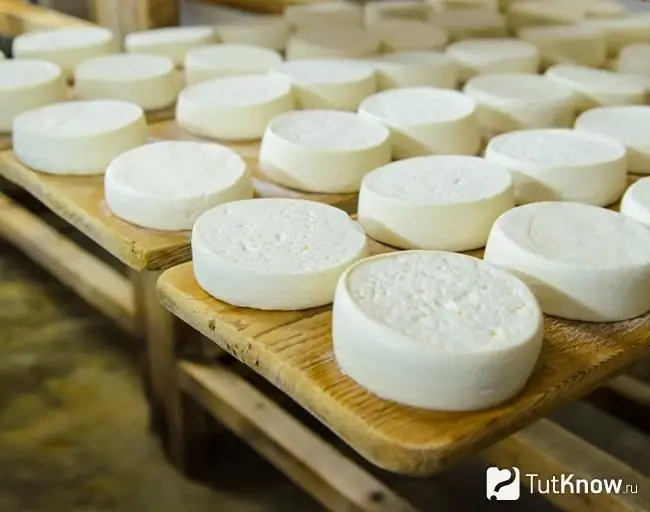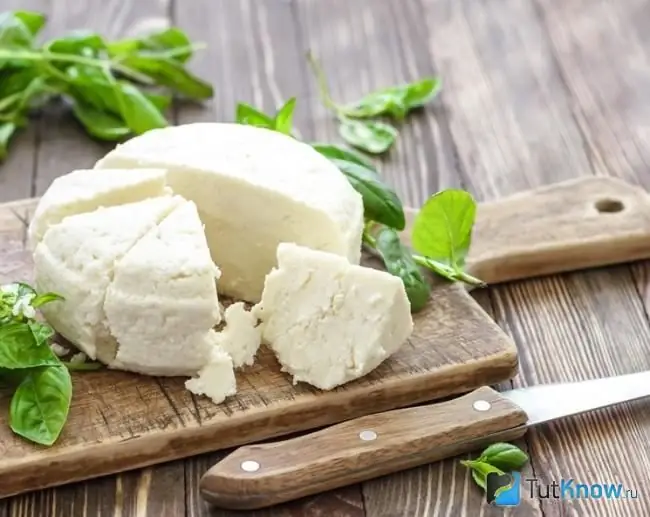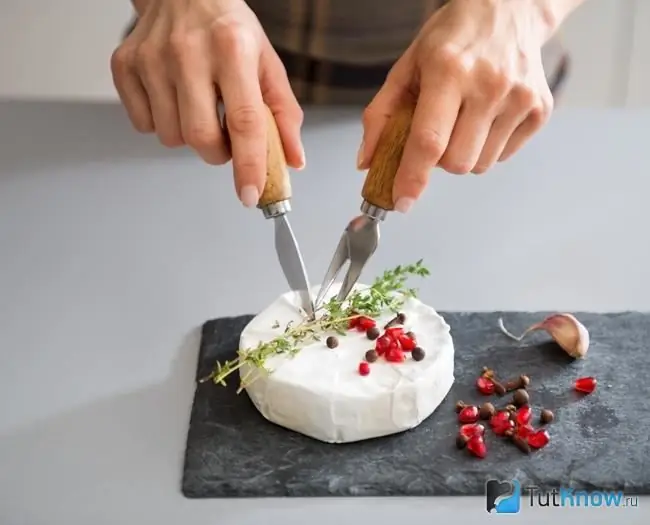- Author Arianna Cook [email protected].
- Public 2023-12-17 14:23.
- Last modified 2025-01-23 09:40.
Description of Robiola cheese and manufacturing method. Energy value and composition of the product, benefits and harms to the body. Recipes with this variety and its history.
Robiola is an Italian soft goat cheese, which, unlike other varieties of the DOP category, is protected not by production technology, but by the breeds of animals from which the raw materials are collected. Therefore, it is made from both raw and pasteurized milk. The texture is dense, soft; taste - creamy, slightly sweet, with nutty; smell - milky or spicy herbal. The crust is natural, light gray or yellowish at the beginning of ripening and reddish with prolonged exposure. The shape of the heads is a spattered cylinder with a diameter of 10-13 cm and a height of 2.5-4 cm. Weight - 250-400 g. The farm product can be produced in the form of parallelepipeds.
How is Robiola cheese made?

Goat's milk is traditionally considered the starting material for the manufacture of this variety, but farmers often use cow's or mix goat and cow's (or sheep's), in proportions of 1; 1, 1: 3 and even 1: 5. If the cow's milk is more than 85%, the heads are only suitable for home use. As a starter, use buttermilk or whey left over from the preparation of a previous batch, or rennet to speed up the process.
How Robiola cheese is made:
- Prepared milk is heated to 32 ° C, if raw materials are raw, and cooled to this temperature, if pasteurized. If a long exposure of the final product is planned, calcium chloride is poured into the milk.
- First, the starter is introduced, then the rennet and wait until the kale is formed. They maintain a constant temperature all the time - for this it is convenient to periodically put the container in a water bath.
- Check the curd layer for a clean break. To do this, lift the calya with a slotted spoon or the plane of the knife blade and see what shape the crack has. Smooth, which is immediately filled with whey, indicates that you can start cutting the cheese grains. If the layer crumbles, you need to wait some more time.
- The dimensions of the edges of the cheese grains are 10 mm. According to the recipe for making Robiola cheese, after cutting, the intermediate raw materials are allowed to stand for 10 minutes.
- Stir slowly. At the same time, the cheese mass is not heated. The process takes 10-15 minutes, and then they wait the same time until the grains settle.
- The cheese mass is laid out in a mold, covered with gauze, folded in several layers, and compacted with your hands. It is convenient to use wicker baskets at home. That is why the surface of the farm cheese has a beautiful structure - the imprint of the weaving of a willow basket.
- To separate the whey, the cheese in gauze is turned over into a bowl, again into a mold in the cloth, repeating the action up to 4 times within 1 hour. The fabric is then removed and placed in a basket or mold. Turn over after 6-10 hours and leave for the same time.
- To prepare the brine, salt is poured into boiling water - in a ratio of 5: 1. Brine 20% is cooled and a sufficiently compressed and formed head is lowered into it. Leave for a day, allow to dry at room temperature for 3 days. At this stage, you can already taste it.
- The long-aged Robiola cheese recipe at home is distinguished by the salting stage. In this case, dry salting is carried out by rubbing coarse salt into the surface.
- For ripening, the cheese is sent to a room with a temperature of 15-16 ° C and a humidity of 90-95%. Already on the fourth day, a light thin crust is formed.
Fresh cheese tastes like other soft varieties of goat milk, Fetu or Adyghe. And already on the 10th day of aging, it becomes more refined, piquant. On the 30th day, the cheese becomes dryish, with nutty and sourness. The pulp is not pasty, it is already being cut. Sometimes it is left to mature for another 1 month.
The degree of exposure can be determined visually. Fresh cheese is white or ivory-colored, and if touched, it will feel firm. After maturing within 10 days, a straw-colored crust appears, on which white mold "blooms". It should be removed before use. But the heads with long exposure have a red-orange crust, dense, smooth and dry. When cut, a yellowish flesh is visible, which is easy to cut. The smell also changes - from a hint of fresh meadow grass to spicy-nutty.
Composition and calorie content of Robiola cheese

The energy value of the variety depends on the type of raw material and the degree of aging. The longer it is, the denser and sweeter the pulp, the more carbohydrates it contains.
The calorie content of Robiola cheese made only from goat's milk is 337 kcal per 100 g, of which:
- Proteins - 20-27 g;
- Fats - 27, 7-33 g;
- Carbohydrates - up to 0.7 g.
If the raw material is pasteurized, and the composition is mixed with cow's milk, the calorie content of Robiola cheese is reduced to 274 kcal per 100 g, of which:
- Proteins - 16, 3 g;
- Fats - 22.5 g.
Vitamins per 100 g:
- Thiamine - 0.05 mg;
- Riboflavin - 0, 24 mg;
- Niacin - 0.8 mg;
- Retinol - 2.93 mg;
- Ascorbic acid - 2.0 mg;
- Vitamin E - 0, 24 mg.
Minerals per 100 g:
- Sodium - 1110 mg;
- Potassium - 96 mg;
- Iron - 0.70 mg;
- Calcium - 704 mg;
- Phosphorus - 374 mg;
- Zinc - 4.1 mg
Cholesterol - 94 mg per 100 g.
Also in the Robiola cheese:
- saturated fats - an energy reserve for the human body;
- peptides - chains of amino acids necessary for the formation of proteins;
- simple carbohydrates - lactose, milk sugar, which is broken down into glucose and galactose, normalizing the composition of the intestinal flora.
The product is classified as gluten-free.
When replacing rennet from the stomach of lamb with a vegetable sourdough, for example, fig or fenugreek juice, Robiola cheese is allowed to be included in the diet of vegans. In terms of nutritional value, the changes are insignificant.
Useful properties of Robiola cheese

Due to the high amount of salt, the fermented milk product reduces the rate of peristalsis and retains water in the body. In people prone to diarrhea, such an addition to the daily menu normalizes bowel function.
The benefits of Robiola cheese:
- It stabilizes the nervous system and improves impulse conduction.
- Increases the general tone of the body and blood pressure.
- Replenishes calcium reserves and prevents the development of osteoporosis.
- Saturates quickly and helps to recover from physical exhaustion.
- Supports the health of the visual system.
- Improves memory and restores the ability to remember.
- Accelerates the regeneration of epithelial tissues and the work of hair follicles.
- Normalizes acid-base balance and maintains a constant rate of metabolic processes.
- Creates favorable conditions for the development of lactobacilli in the small intestine.
- Stops the development of caries, inhibits the activity of pathogenic flora in the oral cavity.
- It is recommended to include in the diet of patients after surgical interventions on the musculoskeletal system.
Robiola cheese is especially useful for women. With its help, you can delay the onset of age-related changes, improve the quality of skin and hair, and strengthen teeth. In addition, it supports the reserve of vitamins and minerals, helps to restore the physical and emotional state during the transition to menopause, and to reduce the number and severity of hot flashes.
Through fermentation, proteins and lipids that enter the body are quickly converted into energy. To spend calories equivalent to 100 g of the product and avoid the formation of a fat layer, it is enough to clean the apartment for 2 hours, walk the same time, run slowly for 40 minutes or do table tennis workout. But you can make calories burn in another way - watch TV for 2, 20 hours without stopping for a snack.






